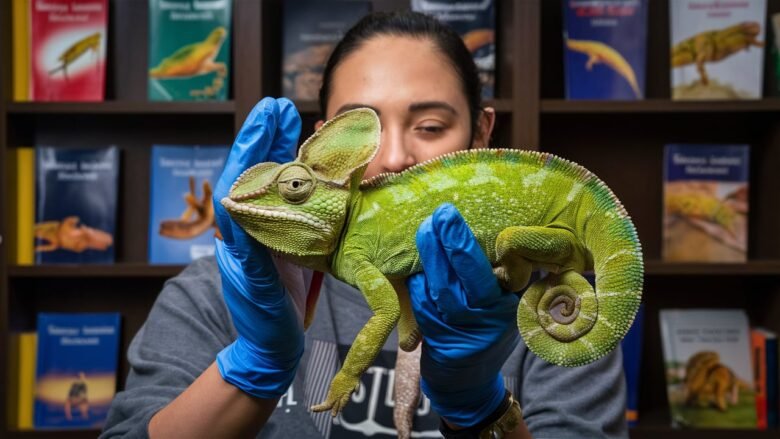Reptiles are fascinating creatures, yet they can experience stress, which negatively impacts their health and well-being. Understanding the signs of stress in turtles, calming techniques for snakes, and strategies for reducing anxiety in lizards is crucial. This article delves into effective stress management techniques tailored for various reptile species, enabling owners to create a calmer environment for their pets.
Understanding Reptile Stress
Understanding Reptile Stress
Stress in reptiles refers to their physiological responses to environmental pressures, differing significantly from mammals. While mammals might exhibit short-term emotional reactions, reptiles experience a more prolonged state of stress with far-reaching effects. This can lead to heightened cortisol levels, suppressing their immune system and increasing susceptibility to illness. Understanding stress’s impact on behavior, such as aggression or lethargy, and health, such as infections or digestive issues, is vital. Timely recognition and management of stress not only enhance their quality of life but also foster better owner-pet relationships, thereby ensuring their long-term well-being and survival in captivity.
Signs of Stress in Turtles
Turtles display stress through various indicators, requiring careful observation by their owners. One prominent sign of stress is **changes in feeding habits**, such as decreased appetite or refusal to eat altogether, often indicating a lack of comfort within their environment. Additionally, **abnormal swimming patterns**—such as erratic movements, prolonged floating, or excessive basking—can signify distress, especially if engaged in these behaviors excessively. Stress is also evident in **hiding behavior**, where turtles seek refuge under rocks or in vegetation, avoiding open spaces that may feel unsafe.
Important **shelly characteristics** should not be overlooked. For instance, **shell retraction**—when a turtle pulls its limbs and head into its shell more than usual—can be a direct response to perceived threats or discomfort. Furthermore, alterations in **coloration changes**, where a typically vibrant shell dulls or becomes darker, may indicate stress or health issues. Understanding these signs helps owners quickly identify underlying stressors, facilitating timely interventions to reduce distress and promote a healthier, happier turtle.
Calming Techniques for Snakes
To effectively calm snakes experiencing stress, focus on habitat adjustments, ensuring a secure enclosure that minimizes external threats. Utilize appropriate temperature gradients, as snakes require certain heat levels for optimal physiological functioning; too much or too little heat can induce anxiety. Offer environmental enrichment, such as hiding spots, branches, and varied textures, promoting natural behaviors that foster relaxation.
Additionally, implement gentle handling practices that minimize disturbance; avoid overhandling during acclimation periods. Ensure that direct contact is limited and done only when necessary, as many snakes find human interaction stressful.
Creating a soothing atmosphere further aids in calming your snake; consider dim lighting to reduce visual stimulation and maintain steady humidity levels for comfort. Regularly monitor the enclosure conditions, as consistency provides a sense of security, allowing stressed snakes to thrive while alleviating anxiety.
Understanding Snake Behavior
Understanding common snake behaviors is essential for effective stress management. Signs of stress often manifest as aggression or prolonged hiding. An aggressive snake may strike, hiss, or display defensive posturing, indicating it feels threatened or overwhelmed. In contrast, a snake that retreats into its hide may be attempting to create distance from stressors.
Differentiating between normal behavior and stress-induced actions is crucial. For instance, while occasional hiding is typical, persistent avoidance suggests a need for intervention. Observing your snake’s reactions, such as food refusal or excessive defense, indicates potential stress levels.
Implementing effective care practices is key to alleviating stress. Ensure the habitat is comfortable; inadequate space or unsuitable temperatures can increase anxiety. By understanding these behaviors, owners can maintain a more serene environment, fostering healthier interactions with their snakes.
Reducing Anxiety in Lizards
Recognizing and alleviating anxiety in lizards is essential for their well-being. Providing adequate hiding spots is crucial, as these creatures instinctively seek cover when feeling threatened. Strategically placing caves, foliage, and shelters creates a sense of security, allowing lizards to escape perceived dangers.
Maintaining appropriate temperature and humidity levels plays a vital role in reducing lizard stress. Lizards rely on their environment to regulate body temperature—ensuring proper heating and cooling gradients can prevent overheating or chilling, both of which heighten anxiety. Proper humidity levels are also essential for hydration and overall comfort, further stabilizing their emotional state.
Establishing a consistent feeding schedule contributes significantly to a lizard’s sense of security. Regular feeding times help them anticipate and prepare for nourishment, reducing anxiety associated with food scarcity. Offering a balanced diet enhances their health and disposition, mitigating stress caused by malnutrition.
Social interactions are equally important in fostering a calm demeanor in pet lizards. Gentle handling techniques, such as slow, purposeful movements, help build trust between the owner and the lizard. Avoiding sudden gestures can make the lizard feel more at ease, creating a peaceful bond that reduces overall stress levels.
By recognizing these factors and implementing specific strategies, owners can effectively reduce anxiety in their lizards, creating a more relaxed and healthy environment that positively influences their well-being and behavior.
Environmental Enrichment for Reptiles
Creating a vibrant environment helps reduce reptile stress effectively through enrichment.
Provide various climbing structures to engage turtles, snakes, and lizards physically.
Incorporate water features, allowing hydration and thermoregulation, enhancing comfort and stimulation.
Include diverse hiding spaces, promoting security and a sense of safety within their habitat.
Naturalistic setups replicate their wild environment, fostering wellbeing and encouraging natural behaviors.
Utilize substrate types that allow burrowing or digging to create an immersive experience.
Introduce plants and foliage to offer visual barriers and promote exploration and activity.
Rotate enrichment items regularly to maintain novelty, preventing boredom and promoting engagement.
Interactive toys that stimulate foraging behaviors can further enhance mental stimulation and enjoyment.
Implementing an enriched environment aids in stress reduction, significantly improving reptiles’ quality of life.
Addressing Health Issues Related to Stress
Prolonged stress in reptiles can lead to critical health issues, including diminished immune responses.
Repeatedly stressed reptiles may experience metabolic disturbances, leading to weight loss or growth issues.
Common signs of these health problems include lethargy, reduced appetite, and unusual behavior.
Regular veterinary check-ups are vital for early detection of stress-induced health complications.
Early intervention can prevent minor stressors from escalating into severe health crises.
Frequent health screenings allow for timely adjustments in diet, habitat, and care routines.
Understanding the relationship between stress and health encourages owners to prioritize their reptiles’ well-being.
Implementing proactive measures, such as monitoring behavioral changes, is essential in stress management.
Long-term Stress Management Strategies
Long-term stress management in reptiles relies heavily on diligent care, structured environments, and consistent observation.
Establishing a predictable care routine can significantly reduce stress levels, as reptiles thrive on familiarity. Providing a stable habitat with temperature gradients and appropriate humidity fosters security, essential for their well-being.
Monitoring for signs of discomfort or behavioral changes should be performed regularly to ensure a balanced physical and mental state.
Deepening your understanding of species-specific needs is crucial. Engaging with educational resources, including expert literature, webinars, or community forums, empowers owners to create optimal environments.
Remember that the investment in ongoing education not only enriches your reptile’s life but also strengthens the human-animal bond, enhancing both their quality of life and your expertise.
Conclusions
In summary, understanding and managing reptile stress is vital for their health and happiness. By recognizing the signs of stress in turtles, employing calming techniques for snakes, and reducing anxiety in lizards through environmental enrichment, reptile owners can ensure a more peaceful and fulfilling life for their pets. Continuous learning and adaptation are key components in providing optimal care.



